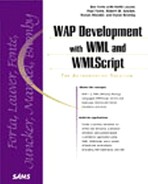Summary
E-commerce is a highly practical and exciting application for mobile users. For this fourth and final sample application, we showed you a complex example of how an e-commerce application might work using JSP and WAP. We showed you what kinds of data we needed to store in the data source, and how the set of tables we created were used throughout the application.
Next, we showed you how to keep track of the user's shopping session with a specific User ID that was passed throughout the application. Once that was established, we dynamically generated categories and product lists, so that the application would be scalable and able to adapt to changing products and additional categories. To keep track of the users'selections, we created a familiar "shopping cart," which held items until they were ready for purchase. Finally, we created a way for the user to purchase those items by collecting purchase information and storing that data with the product data in a separate table.
Although this e-commerce application was fairly straightforward, we built it in such a way that additional products or categories could, at any time, be added to the data source without requiring any changes to the code shown here. This kind of scalability will be critical for other kinds of e-commerce applications, because products and pricing can change at a moment's notice.
WAP is a powerful way to interface with mobile devices. When joined with a more dynamic technology, like JSP, the full potential of WAP can be realized in all kinds of applications, such as e-commerce. It is then that we can bring any kind of data to anyone, anywhere, using WAP.
